Altair Slitherlinks
 I’m working on a set of Slitherlink puzzles based on the Islamic-inspired tiling shown here, from Ensor Holiday’s book “Altair Design”. The pattern contains tiles with 4,5,6,7 and 8 sides, which makes the puzzle a little more interesting than my previous Slitherlinks, which only use tiles with 4 sides.
I’m working on a set of Slitherlink puzzles based on the Islamic-inspired tiling shown here, from Ensor Holiday’s book “Altair Design”. The pattern contains tiles with 4,5,6,7 and 8 sides, which makes the puzzle a little more interesting than my previous Slitherlinks, which only use tiles with 4 sides.
You can preview some sample puzzles by downloading this PDF file and printing it.
Thanks to Craig Kaplan for suggesting the use of the Altair tiling.
UPDATE: Here are 100 booklets of these new puzzles. Enjoy!


March 31st, 2008 at 7:58 pm
[…] is working on creating a new type of slitherlink puzzle called Altair slitherlink. The grid for the puzzles is based on a medieval Islamic […]
April 15th, 2008 at 1:14 pm
I think I enjoyed this version of Slitherlinks the most. Not the hardest, but a nice combination of visual attractiveness, needing to be careful, and requiring you to develop some consistant logic. The fact that the valence of each point is 3 allows some consistancy in choosing paths, but the variety of number of sides adds a new dimension. Hopefully some future books of this type will be posted.
April 23rd, 2008 at 4:56 pm
I’ve posted 100 books of these puzzles on my slitherlink pages.
http://www.krazydad.com/slitherlink/index.php?fmt=altair
April 29th, 2008 at 3:06 pm
hi krazydad,
i’m really hooked on those puzzles, i’ve solved one intermediate and one hard one of the sample puzzles. what bothers me is that i can find at least 3 possible solutions for the #5 tough sample puzzle. the area with the variation is on the far left side of the puzzle. can you confirm that? i might be mistaken as well. i’ll try to scan my solution and send it to you.
until then, best regards
Mihkel
April 29th, 2008 at 3:18 pm
If you spot an alternate solution, scan or photograph your result and send it to me (dad at krazydad.com), so I can take a look.
Thanks!
May 30th, 2008 at 11:56 am
Hi and thank you very much for your puzzles. I especially enjoy the Laves and Penrose slitherlinks. They’re similar enough to regular square-grid-based slitherlinks that some of the tricks and shortcuts work; but they’re different enough to feel like I’m solving puzzles in some kind of alternate dimension where the ordinary laws of physics don’t apply. [g]
I simply don’t grasp how to even begin to solve the Altair ones, though. Each space has so many sides that I don’t understand how to reduce the number of possibilities enough to get a toehold. How do you get started? I realize it’s not easy to provide a verbal answer, but – um – well, please, if you can give me a hint or two, I’d really appreciate it. Thank you.
May 30th, 2008 at 12:15 pm
Ok, I sat down with a sample puzzle and was able to get a handle on it. So I think I answered my own question. These are quite fun also. I don’t know what I’d do if I didn’t have a 0 to start with though.
thanks again
Christian [yes I was named after that Dutch guy] [g]
May 30th, 2008 at 1:27 pm
Hey Christian,
First of all, you have an awesome name.
Another puzzle starter is something like a 5 in a hexagon which is on the border, and 4 sides which are on the border. In this case, all the border edges must be filled in (this rule holds as long as the clue is larger than the number of non-border edges). If the border edges were skipped, there wouldn’t be enough remaining edges to fill the required number of edges. If one border edge is filled, they must all be filled.
Also look for two adjacent cells in which the clues are the maximum possible number (which is one less than the number of sides of the cell).
So for example, you have a 4 inside a pentagon, which is adjacent to a 5 in a hexagon.
In these cases, the side that the two cells share is always filled in, and the sides that don’t touch the adjacent polygon are always filled in.
June 11th, 2008 at 8:05 am
Thanks Jim for the hints. I am having fun with these.
regards,
Christian
April 24th, 2010 at 1:27 am
[…] called Altair Slitherlink and is based on the medieval Islamic tiling. The pattern contains tiles with 4,5,6,7 and 8 sides, […]